Onsen Towns Near Osaka and Kyoto: The Best Hot Springs

Discover Kansai's best onsen towns! From tattoo-friendly hot springs in Kinosaki and Arima Onsen to affordable, cheap onsen options—our guide has you covered.
Relax at the Best Hot Spring Towns near Osaka and Kyoto
If you want to refresh after sightseeing in Kyoto and Osaka, consider visiting one of the popular hot springs, or onsen towns, nearby.
In hot spring towns like Kinosaki Onsen or Arima Onsen, you can enjoy relaxing baths, beautiful natural scenery, and delicious local cuisine at traditional ryokans (Japanese inns).
Let's explore some popular onsen towns and hot springs near Osaka and Kyoto that are perfect for a day trip of relaxation. We also introduce spa facilities within Osaka and Kyoto for those who prefer to stay within the city.
Hot Spring and Spa Facilities near Osaka and Kyoto
Going to the Onsen or the Sento? Disambiguation
Onsen: Natural Hot Springs with Mineral Content
Sento: Public Bathhouse with Heated Water
Top 7 Hot Spring Towns near Osaka and Kyoto
1. Kinosaki Onsen: A Picturesque Hot Spring Town with Rich History - (Tattoo Friendly)
2. Arima Onsen: One of Japan’s Oldest Hot Springs - (Tattoo Friendly)
3. Nagahama Onsen: Hot Springs by Lake Biwa
4. Shirahama Onsen: Gorgeous Hot Spring Town with Ocean Views
5. Dorogawa Onsen: A Mountain Hot Spring Town
6. Wakura Onsen: Luxurious Hot Springs by the Sea of Japan
7. Kaga Onsen: Charming Townscapes and Local Handicrafts
Spa Facilities within Osaka and Kyoto
8. Spa Facilities in Osaka
9. Spa Facilities in Kyoto
10. Tips for Visiting Onsen with Tattoos
Going to the Onsen or the Sento? Disambiguation
Onsen: Natural Hot Springs with Mineral Content

Onsen: natural hot spring bath. Photo by Pixta
The word "onsen" means "hot springs" (geothermal springs), but it can refer to either hot spring towns like the ones featured below or hot spring facilities.
Hot spring towns are usually located in volcanic areas where the naturally heated mineral springs are abundant. There are usually many ryokans (Japanese inns) and hotels in onsen towns, each provided with large bathing facilities where staying guests can enjoy the blessings of hot springs.
A hot spring facility, often called "higaeri onsen" in Japanese, does not provide accommodation; you visit it for the sole purpose of taking a hot spring bath.
Natural hot springs are valued for their mineral content, which promotes overall health. Some onsen are famous for their skin-beautifying effects, while others help relieve rheumatic pain and various other conditions.
Because of these health benefits, onsen play an important role in Japanese wellness and relaxation traditions.
Sento: Public Bathhouse with Heated Water
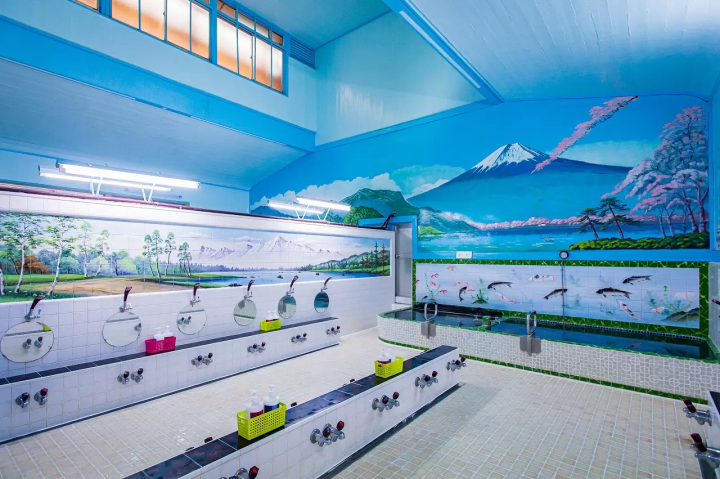
Sento (public bathhouses) often have an image of Mt. Fuji painted on the wall. Photo by Pixta
On the other hand, "sento" means "public bathhouse."
Going to the public bathhouse was very common in the past when houses were not provided with private bathing facilities. Cities like Tokyo, Kyoto, and Osaka had a sento for every block.
The number of sentos has decreased a lot in recent years, but they are still treasured by local communities as places where people can gather and interact.
At a sento, the water is heated artificially so it is not an onsen. Recently, facilities called super sento have emerged; they are basically spa facilities where visitors can bathe, enjoy the sauna, massages and maybe even skin treatments, as well as dining.
Regardless of their scale and wide range of services, these spa facilities are not onsen unless their bathing water is naturally hot mineral spring water.
In other words, if you're seeking the health benefits of bathing in hot spring water, make sure that the spa facility you're visiting provides onsen. If you visit one of the hot spring towns featured below, you can rest assured that you'll be bathing in an onsen.
↑ Return to the top of article.
1. Kinosaki Onsen: A Picturesque Hot Spring Town with Rich History
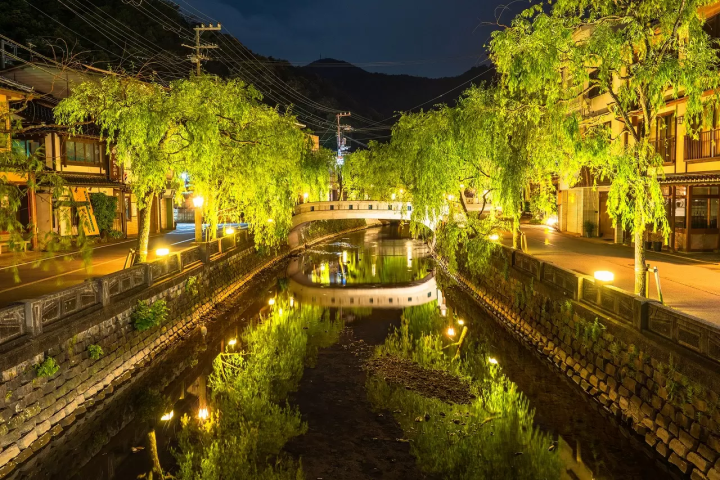
Photo by Pixta
Kinosaki Onsen, located in Hyogo's Toyooka City boasts more than 1,300 years of history. The Otani River runs through this onsen town, and its banks are lined with willow trees and old wooden buildings, giving it a very elegant air.
We suggest spending your time at Kinosaki Onsen wearing a yukata (light kimono) and geta. Explore the town wearing a yukata, take pictures by the beautiful canal and its bridges, and enjoy delicious food.
For other activities, be sure to ride the Kinosaki Ropeway, which offers a spectacular view of the surrounding mountains. There are also a number of museums to satisfy any desire for artistic stimulation.
Tattoo Friendly Onsens
Kinosaki Onsen has built a reputation for being inclusive toward tattooed visitors. Its seven public bathhouses openly welcome tattoos, allowing guests to enjoy the hot springs comfortably without needing to cover tattoos with seals.
Recommended Accommodation in Kinosaki Onsen
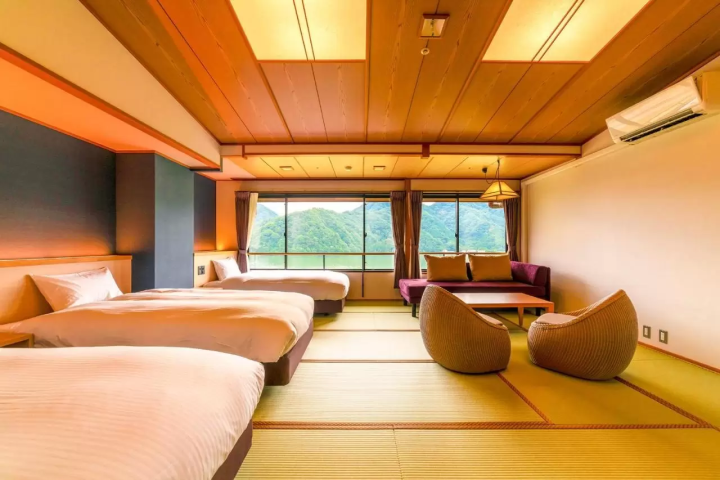
Photo by Booking.com
Ooedo Onsen Monogatari Kinosaki is a stylish Japanese inn where guests receive the Sotoyu Meguri Pass, a ticket that allows them to enjoy seven other bathing facilities around the town.
In addition to the popular buffet-style meals that change every season, there are also complimentary services such as the Premium Lounge where guests can rest and freely enjoy alcohol and ice candy, as well as yukata rental service.
The facility also offers a free shuttle service from Kinosaki Onsen Station; this makes it very easy to access by visitors.
Accessing Kinosaki Onsen from Osaka
The JR Limited Express is the fastest way to get to Kinosaki. Take the Konotori train from Shin-Osaka Station, bound for Kinosaki Onsen Station (2 hours and 44 minutes, 6,140 yen). The town can be reached in about 10 minutes from the station. You can also take the highway bus from Osaka Station or Shin-Osaka Station (up to three hours, starting at 3,000 yen). If you don't mind cramped quarters, it might be good to save money via the bus.
Accessing Kinosaki Onsen from Kyoto
From Kyoto Station, take the JR Limited Express Kinosaki bound for Kinosaki Onsen Station (two hours and 30 minutes, 5,170 yen). There are almost no buses linking Kyoto with Kinosaki Onsen, so if you want to take a bus to save money, head to Osaka to catch one there.
Find accommodation in Kinosaki Onsen on Booking.com
↑ Return to the top of article.
2. Arima Onsen: One of Japan’s Oldest Hot Springs
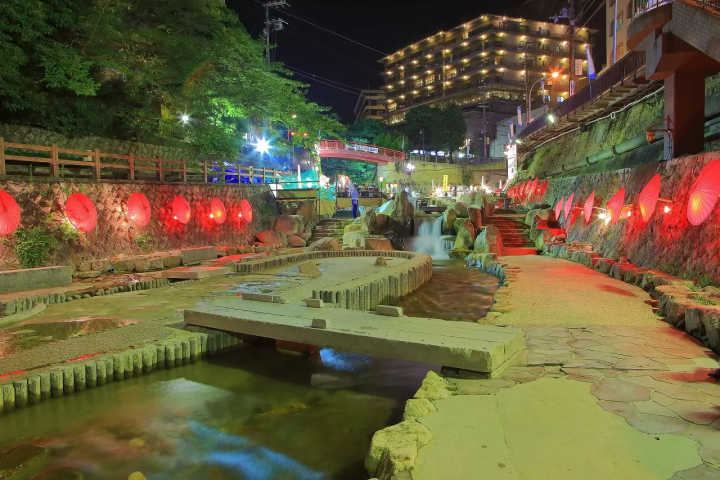
Photo by Pixta
A suburban hot spring resort in the Kansai region, Arima Onsen is in Kobe. It is one of Japan’s three oldest hot springs.
Arima Onsen's narrow, tangled hill roads, surrounded by natural landscape and mountains, like Mt. Rokko, give the area a lot of charm. We recommend enjoying the nature of this area by joining a hiking tour of Mt. Rokko and end with a soak and drink at Arima Onsen.
There are major inns and hotels in the onsen town, at the foot of the mountains, and among the mountains. You can also use the outdoor springs Kin-no-Yu or Gin-no-Yu on day trips. Arima Onsen is comprised of springs containing an unusual amount of ingredients, such as carbonic springs, sulfur springs, chlorinated springs, iron springs, and radium springs. They are said to help with various health ailments.
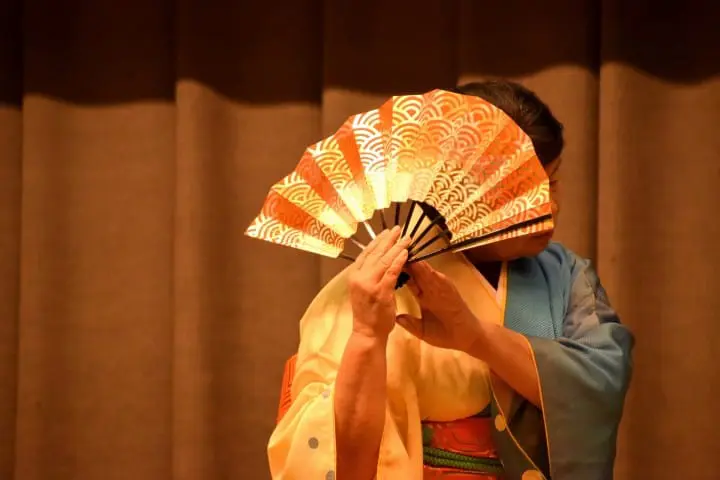
How about enjoying some traditional parlor entertainment at Arima? The area’s geiko perform dances that are appropriate for each season.
Geiko Cafe Ito has days once or twice a month where you can see them dance for the price of a drink. We recommend this cafe because you can easily check out geiko dancing here.
Tattoo Friendly Onsens
In Arima Onsen, traditional public baths often have restrictions on tattoos due to historical associations. However, policies are gradually changing, and some ryokans and facilities are becoming more accommodating, especially for international visitors.
Many ryokans in Arima offer private baths (kashikiri onsen), which are ideal for tattooed guests, as you can enjoy the hot spring privately without restrictions. Well-known inns like Arima Grand Hotel and Kinzan Bekkan provide this option—it's best to contact them in advance to confirm availability.
For public baths such as Kinsen no Yu (Gold Water) and Ginsen no Yu (Silver Water), policies tend to be strict, but some establishments may permit tattooed visitors if they use tattoo seals or covers. Always call ahead to clarify their policies or to request private or semi-private baths.
Recommended Accommodation in Arima Onsen
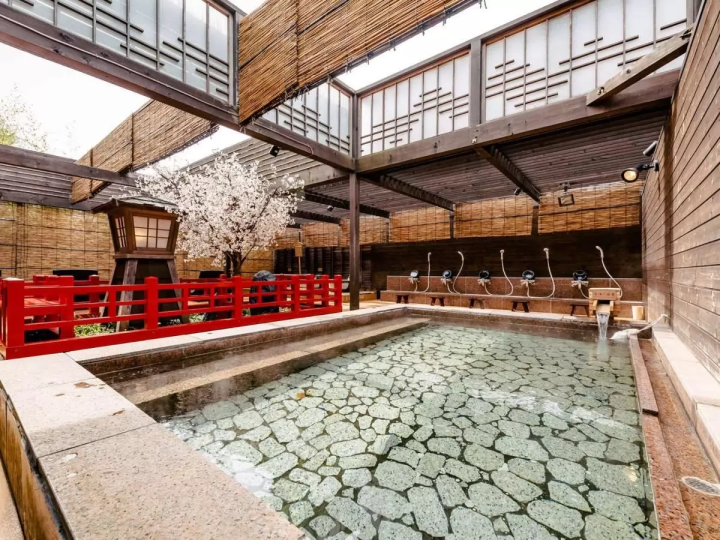
Photo by Booking.com
Arima Kirari is our recommendation for those who want to fully enjoy the hot springs in Arima Onsen.
Here, guests can enjoy the unique gold and silver hot springs of Arima Onsen, as well as 26 different types of hot springs at the hot spring theme park Taiko no Yu located within this Japanese inn.
The inn also offers complimentary services such as a welcome drink and free shuttle service to Arima Onsen Station, bus stops, and the ropeway station.
Accessing Arima Onsen from Osaka
From the bus terminal at Shin-Osaka Station, take the highway bus Arima Express and get off at Arima Onsen (one hour; adults 1,250 yen, children 630 yen). The bus stop is in the center of Arima Onsen.
Accessing Arima Onsen from Kyoto
From Kyoto Station's Hachijo Exit (H2), take the highway bus Arima Express Kyoto and get off at Arima Station (one hour and 15 minutes; adults 1,850 yen, children 930 yen). You can also take the Hankyu or the Keihan bus, which costs the same and takes the same amount of time, so look at the timetables and choose the one that is best for your schedule.
Find accommodation in Arima Onsen on Booking.com
↑ Return to the top of article.
3. Nagahama Onsen: Hot Springs by Lake Biwa

Photo by Pixta
Nagahama is a small city on the coast of Lake Biwa in Shiga Prefecture boasting a large number of onsen ryokan (hot spring inns). Visitors can stay the night at the lodgings or enter the hot springs and baths for the day.
The town is best known for its castle, which belonged to the famous feaudal lord Toyotomi Hideyoshi (1537-1598), its gorgeous glass, and picturesque lakeside hot springs. It is a great destination for those looking for a relaxed hot spring experience and encounters with history. Its relatively close proximity to both Osaka and Kyoto also makes it an ideal choice.
Before or after soaking in the hot springs, explore Kurokabe Square, a charming shopping district where you can enjoy some of Nagahama's specialties.
Glassware, in particular, is well-known; there are numerous souvenir shops selling cups, plates, and other decorations, and there are also glass-blowing and engraving workshops to try. Stop by the cafes, restaurants, and eateries offering local dishes when you get hungry.
Reccomended Hotel in Nagahama
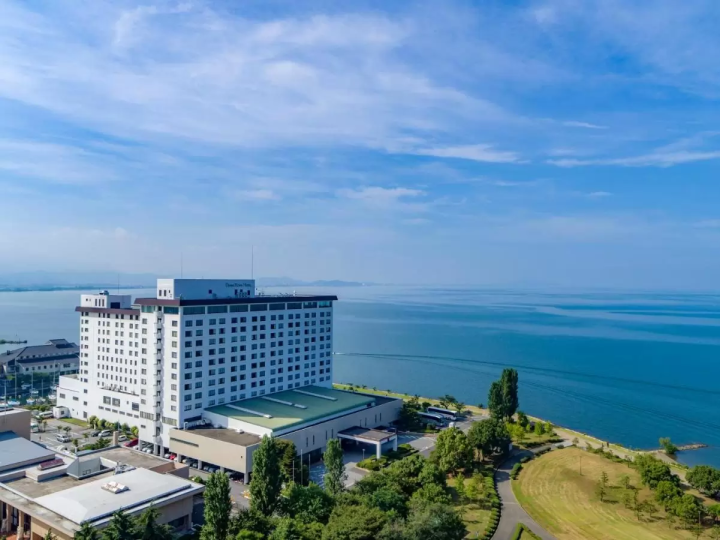
Photo by Booking.com
Hotel & Resorts Nagahama is located by the shores of Lake Biwa, serving as an excellent base for exploring Nagashima.
Guests can enjoy the hot springs in the open-air baths within the hotel. Nagahama Castle is easy to reach on foot from here, as well as the port where the ferries for Chikubushima Island depart from.
Furthermore, on clear days, guests can enjoy breathtaking views at dusk from their rooms or the restaurant! The sunset views from here have been selected as one of Japan's Top 100 Sunsets. There is also a complimentary shuttle service available from Nagahama Station.
Accessing Nagahama Onsen from Osaka
Take the Tokaido-Sanyo Line Special Rapid towards Tsuruga from JR Osaka Station to Nagahama Station. The ride takes about one hour and 40 minutes and costs 1,980 yen.
Accessing Nagahama Onsen from Kyoto
Take the Tokaido-Sanyo Line Special Rapid towards Nagahama from JR Kyoto Station to Nagahama Station. The ride takes about one hour and costs 1,340 yen.
Find accommodation in Nagahama Onsen on Booking.com
↑ Return to the top of article.
4. Shirahama Onsen: Gorgeous Hot Spring Town with Ocean Views

Picture courtesy of Shirahama Tourism Association
Located in the Nishimuro area of Wakayama Prefecture, Shirahama Onsen is a highly acclaimed hot spring area. It has a very long history, as it is mentioned in Japan’s oldest songbook and historical texts.
Set against the contrast of the emerald ocean and white sand beach, and with many lodging establishments nearby, it is a leading Kansai tourist destination. There are carbonic, chlorine and sulfuric springs at Shirahama Onsen, and the water is said to be good for nerve pain, chills, skin diseases, diabetes, and other illnesses. Even today, Shirahama Onsen boasts many directly sourced springs and an abundance of water.
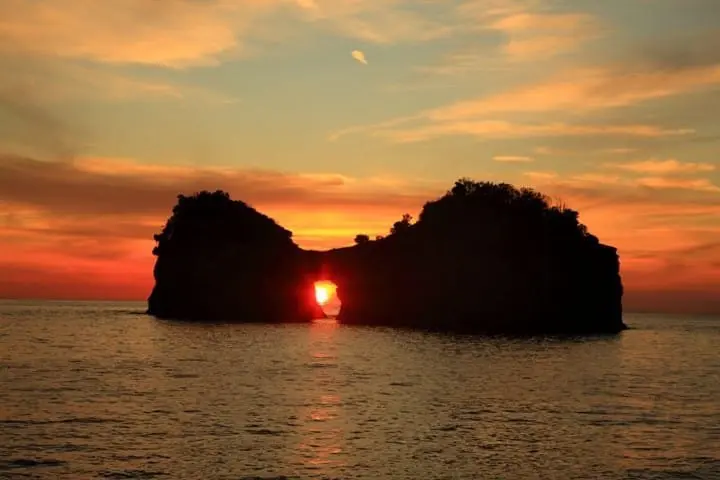
Picture courtesy of Shirahama Tourism Association
Shirahama Onsen faces the ocean, so you can have a soak while enjoying ocean views. The setting sun over the ocean waters is beautiful and spiritually soothing. Nanki-Shirahama has been long known for its picturesque scenery, including white sandy beaches and precipitous cliffs.
Recommended Hotel in Shirahama Onsen
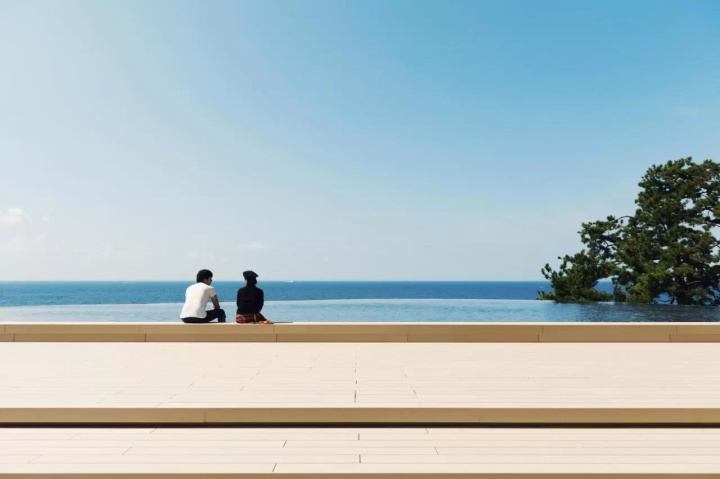
Photo by Booking.com
Opened anew after renovations in April 2023, Shirahama Key Terrace Hotel Seamore (commonly known as Hotel Seamore) is now gathering a lot of attention.
The biggest attraction of the hotel is the open-air baths and infinity foot baths that provide a sense of being in the ocean. Additionally, from May to September, guests can also enjoy a 32-meter-long infinity pool.
For those who want to spend a luxurious time in a stylish hotel space with ocean views, please be sure to check it out.
Accessing Shirahama Onsen from Osaka
From JR Shin-Osaka Station, take the JR Limited Express Kuroshio train bound for Shingu, and get off at Shirahama Station (around two hours and 37 minutes, 5,610 yen). Another convenient option is the Onsen Bus, which goes directly to Shirahama Onsen (two hours and 30 minutes, 3,000 yen) from JR Osaka Station.
Accessing Shirahama Onsen from Kyoto
The highway bus is best when coming from Kyoto! Take the Meiko bus from Kyoto Station, which stops at every location in Shirahama, and get off at your destination (four hours, 3,500 yen). There are very few buses (only two a day), so be careful. Alternatively, those in Kyoto can travel to Shin-Osaka and take the Kuroshio limited express from there.
Find accommodation Shirahama Onsen on Booking.com
↑ Return to the top of article.
5. Wakura Onsen: Luxurious Hot Springs by the Sea of Japan

Photo by Pixta
Wakura Onsen is located in Ishikawa's Nanao City. It is said to have a history of more than 1,200 years and is a leading high-class onsen town.
In addition to the hot springs, you can see the famous Buddhist temples around the town, enjoy fresh fish caught from Nanao Harbor and the neighboring Tomiyama Harbor, and other things that let you experience the true charm of touring Japan.
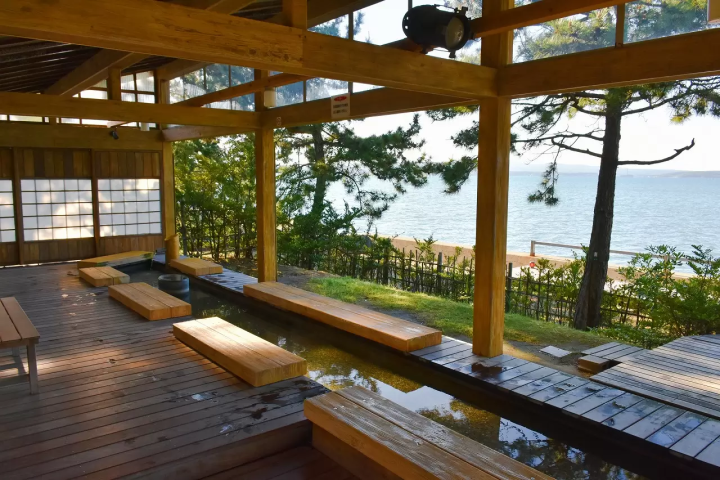
The view from Yuttari Park in Wakura Onsen. Photo by Pixta
Wakura Onsen’s hot spring water contains sodium and calcium and is said to be good for rheumatism and nerve pain. The town faces the Sea of Japan, and its water has a high salt content that is characteristic of a seaside onsen.
Wakura Onsen is famous for its flavorful rice, vegetables, local sake, Noto beef, and other specialties. At Nanao Harbor and Tomiyama Harbor, yellowtail, Kano crab, rockfish, anglerfish, and other kinds of seafood can be caught in front of your eyes. The town has plenty of restaurants so enjoy the flavors of the Noto Peninsula to your heart’s content.
Recommended Accomodation in Wakura Onsen
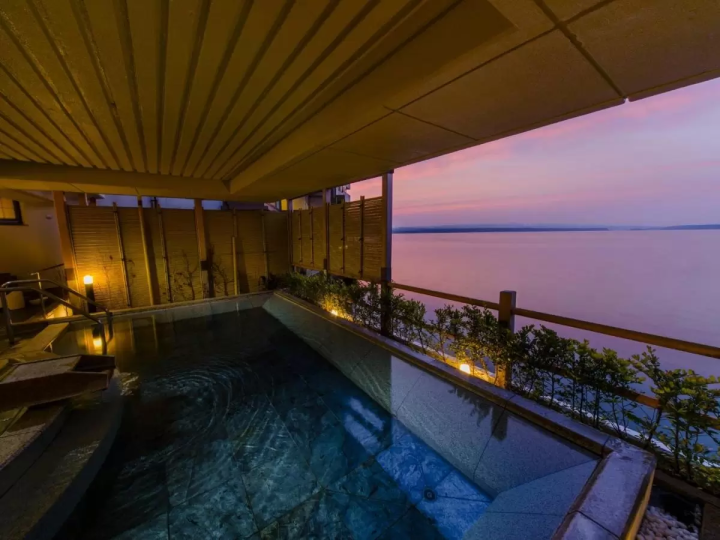
Photo by Booking.com
Wakura Onsen has many hot spring ryokans, public bathing facilities known as the Wakura Onsen Sotoyu, and foot baths.
Among them, the most famous is the hot spring ryokan Kagaya, which has been chosen as the number one hotel or ryokan in Japan for over 30 years in the Hotels & Ryokans 100 Selection by professionals.
This luxurious ryokan facing Nanao Bay boasts a history of over 110 years and is known for providing top-notch Japanese hospitality.
Additionally, the ryokan offers hot spring facilities that make use of its location, including the Floating Open-Air Bath that evokes the feeling of soaking in the sea. There is also a complimentary shuttle service to Wakura Onsen Station.
Accessing Wakura Onsen from Osaka
From Osaka Station, take the JR Limited Express Thunderbird bound for Wakura Onsen, and get off at Wakura Onsen Station (four hours, 8,830 yen).
Accessing Wakura Onsen from Kyoto
From Kyoto Station, take the JR Limited Express Thunderbird bound for Wakura Onsen, and get off at Wakura Onsen Station (three hours and 20 minutes, 8,060 yen).
Find accommodation in Wakura Onsen on Booking.com
↑ Return to the top of article.
6. Dorogawa Onsen in Nara: A Mountain Hot Spring Town

Photo by Pixta
Dorogawa Onsen is nestled in the Omine Mountains of eastern Nara Prefecture. Historically used for religious training, the area is thought to have a relaxing and spiritual atmosphere.
The region also receives natural hot springs flow, making it a great spot to experience onsen culture in western Japan. There are numerous inns with hot spring baths and places to stop in for a quick soak after hiking and sightseeing at the temples and natural sights in the area.
Recommended Accommodation in Dorogawa Onsen
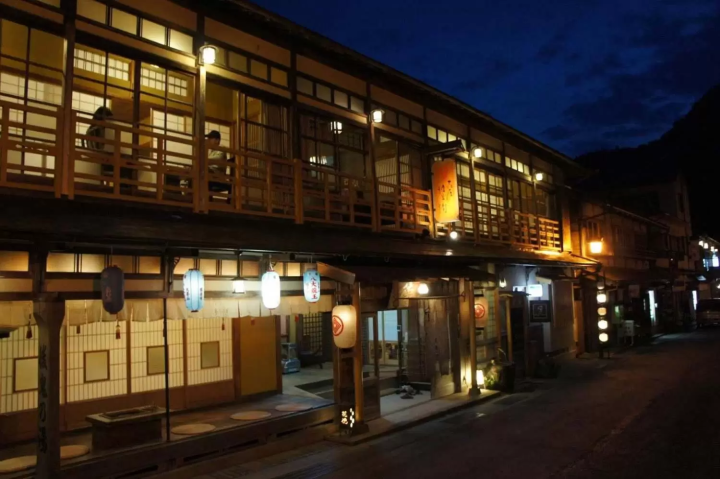
Photo by Booking.com
Hanaya Tokubei is a charming traditional ryokan (Japanese inn) with a history of 500 years.
The ryokan features three types of baths: an indoor bath that can be used 24 hours a day, a semi-outdoor bath where you can enjoy the snowfall in winter, and a private rental hot spring bath. For those who prefer privacy, it is recommended to stay in a room with a scenic hot spring bath or use the private rental hot spring bath.
Reservations are limited to six groups per day, so make a reservation early if you are interested.
Accessing Dorogawa Onsen from Osaka
You must make a few transfers to get to Dorogawa Onsen from Osaka. Start at JR Osaka Station and take the Osaka Loop Line to Tennoji Station. From Tennoji Station, transfer to the Kintetsu Minami Osaka line headed for Yoshino. The rapid service train will take one hour to get to Shimo Ichiguchi Station. From Shimo Ichiguchi Station, take the bus to Dorogawa Onsen (around 78 minutes). Please note the bus only runs a few times a day. The total cost of the trip is around 2,000 yen (one-way).
Accessing Dorogawa Onsen from Kyoto
To get to Dorogawa Onsen from Kyoto, take the rapid service train bound for Yoshino from Kintetsu Kyoto Station. After around one hour and thirty minutes, get off at Shimo Ichiguchi Station where you can take a bus to get to Dorogawa Onsen.
Find accommodation in Dorogawa Onsen on Booking.com
↑ Return to the top of article.
7. Kaga Onsen: Charming Townscapes and Local Handicrafts
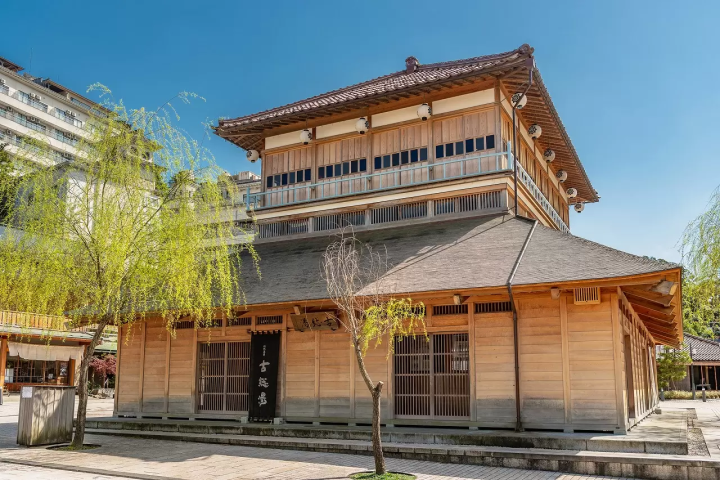
The Kosoyu in Yamashiro Onsen. Photo by Pixta
Kaga Onsen is a cluster of hot spring towns near Kanazawa in Ishikawa Prefecture. Yamashiro Onsen, Yamanaka Onsen, and Katayamazu Onsen are collectively known as Kaga Onsen.
This area is famous for delicate handicrafts such as Kutani porcelain ware; a simple stroll around town is a chance to visit small shops handling these lovely Japanese items and taste exquisite local specialties.
While most hot spring towns have ryokan with private baths for staying guests, in Kaga Onsen, you'll find public hot spring bathhouses called soyu where visitors drop in just to take a hot spring bath. Soyu do not provide accomodation.

Photo by Pixta
Bathing facilities in Kaga Onsen are often decorated with beautiful Kutani porcelain tiles or stained glass tiles, a feature that you won't encounter anywhere else.
Recommended Accommodation in Kaga Onsen
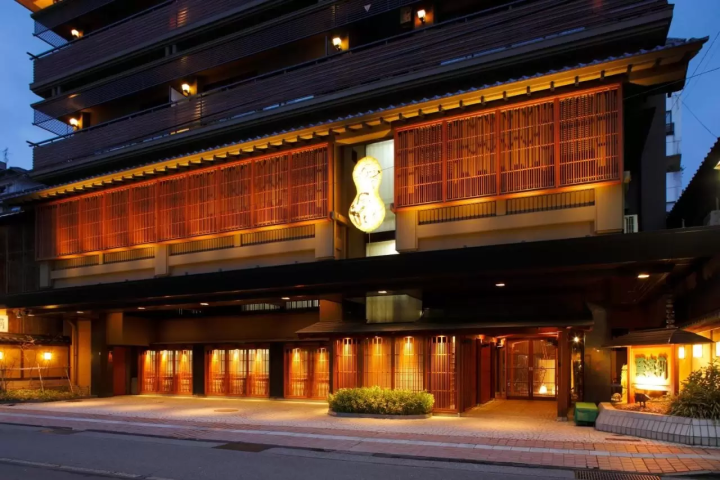
Photo by Booking.com
Hatori is a hot spring ryokan located about a 3-minute walk from Kosoyu, the heart of Kaga Onsen.
The interior of the ryokan has an elegant and serene atmosphere. In addition to two types of hot springs, guests can also enjoy the hot spring facilities of its sister ryokan, Rurikoh, free of charge.
Furthermore, within the ryokan, guests can enjoy complimentary services such as gelato after bathing, as well as activities like karaoke and table tennis. There is also a complimentary shuttle service from Kaga Onsen Station.
Accessing Kaga Onsen from Osaka
The JR Thunderbird Limited Express takes you directly from Shin-Osaka Station to Kaga Onsen Station (2 hours and 14 minutes, 6,820 yen).
Accessing Kaga Onsen from Kyoto
The JR Thunderbird Limited Express takes you directly from Kyoto Station to Kaga Onsen Station (one hour and 49 minutes, 5,940 yen). Otherwise, you can take Shinkansen (bullet train) to Maibara Station and change here for the Shirasagi Limited Express heading to Kanazawa (2 hours and 11 minutes, 6,590 yen)
Find accommodation in Kaga Onsen on Booking.com
Spa Facilities in Osaka and Kyoto
Below we introduce a few hot spring facilities within Osaka and Kyoto for those who wish to enjoy hot spring baths without leaving the great cities.
↑ Return to the top of article.
Onsen Facilities in Osaka
Naniwa no Yu
Naniwa no Yu is a facility with natural hot springs located near Tenjimbashisuji 6-chome Station on the Osaka Metro Sakaisuji and Tanimachi Lines.
They offer a wide variety of hot spring baths, including waters believed to have skin-beautifying effects. The hot springs are sourced from 659 meters underground, providing a genuine natural experience.
Naniwa no Yu
Location: Map
Hours: Monday - Friday 10:00 - 1:00 AM, Saturday and Sunday 8:00 - 1:00 AM
Fees: Adults 950 yen on weekends/850 yen on weekdays, Children 400 yen, Infants 150 yen
Website: https://www.naniwanoyu.com/
Solaniwa Onsen Osaka Bay Tower
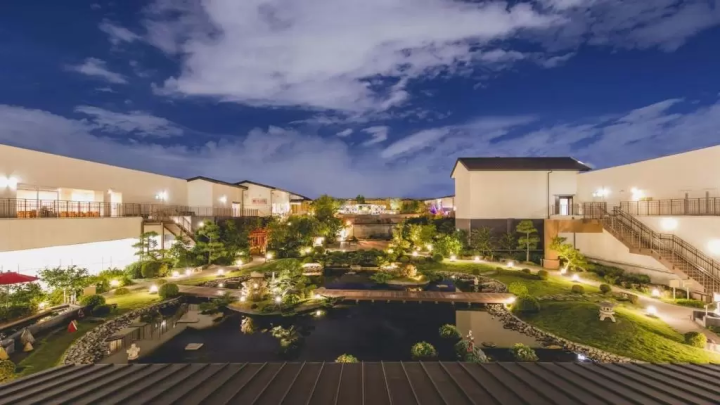
Picture courtesy of Booking.com
Solaniwa Onsen Osaka Bay Tower is a hot spring complex that includes hotel accommodation, dining options, and many other various types of entertainment.
Those who seek modern amenities and an exciting onsen stay with fabulous city views should not miss out on this facility!
Solaniwa Onsen Osaka Bay Tower
Location: Map
Hours: 11:00 - 23:00
Fees: 2,310 yen
Website: https://solaniwa.com/en-us/
Spa World Osaka

One of the bathing rooms at Spa World Osaka. Photo by Pixta
Spa World Osaka is a large onsen facility near the Tsutenkaku Tower in Shinsekai.
They offer an amazingly wide range of bathing facilities inspired by spa traditions worldwide; a visit here is like exploring the world through hot springs!
SpaWorld Hotel & Resort
Location: Map
Hours: 10:00 - 8:45 AM (next day)
Fees: Adults 1,500 yen, Children (under 12) 1,000 yen
Website: https://www.spaworld.co.jp/english/
Onsen Facilities in Kyoto
Sagano Onsen Tenzan no Yu
Sagano Onsen Tenzan no Yu is a hot spring facility in Kyoto that sources its water from 1,200 meters underground. They also offer spa treatments and several dining options.
The facility can be reached in 3 minutes on foot from Arisugawa Station on the Randen Arashiyama Line.
Sagano Onsen Tenzan no Yu
Location: Map
Business hours: 10:00 - 0:00 (*last entry at 23:00)
Fees: Adults 1,200 yen on weekdays/1,300 yen on weekends, Children 550 yen
Website: https://www.ndg.jp/tenzan/en/
Mibu Onsen Hananoyu
Mibu Onsen Hananoyu is located near the JR Tambaguchi Station. This simple hot spring facility with a local flair offers several types of hot spring baths, as well as sauna facilities.
Mibu Onsen Hananoyu
Location: Map
Business hours: 10:00 - 1:00 AM
Fees: Adults 840 yen on weekdays/970 yen on weekends, Children 370 yen on weekdays/420 yen on weekends
Website: https://hanano-yu.jp/ (Japanese)
While experiencing the traditional hospitality of classic hot spring facilities is a cultural experience in itself, visitors seeking the comfort and amenities of modern spa facilities should consider visiting hot spring towns located a bit farther from the major cities.
Onsen towns like Kinosaki Onsen and Arima Onsen are dedicated to relaxation and leisure, offering a blend of traditional charm and modern comfort.
Tips for Visiting Onsen with Tattoos
Visiting onsen with tattoos in Japan requires some extra planning, but following these tips can help ensure a smooth and enjoyable experience:
Private Onsen or Ryokan Baths: Booking a room with a private bath (kashikiri onsen) is often the best option for tattooed guests.
Tattoo Seals: Use a tattoo cover sticker (tattoo seal) to discreetly cover tattoos if using public baths that aren’t explicitly tattoo-friendly.
Check in advance: Always contact the ryokan or facility to confirm their policy regarding tattoos.
Purchasing Tattoo Seals
If you're looking to buy tattoo seals (also known as tattoo cover stickers) in Japan, Don Quijote stores are one of the most convenient options. Donki Hotei, a popular discount store chain, sells a variety of tattoo seals, which are perfect for discreetly covering tattoos at onsen, gyms, or public baths. These stickers are easy to apply and come in different skin-tone shades, making them suitable for various tattoo sizes.
Besides Donki, you can also find tattoo seals at drugstores like Matsumoto Kiyoshi, or online through Japanese e-commerce sites such as Amazon Japan or Rakuten. Always check the product description to ensure the seals are suitable for your skin and purpose, and consider buying a few extra to ensure you’re fully covered during your stay.
Soak in Great Hot Springs in Kansai
Enjoy a short trip from Osaka and Kyoto to head to wonderful onsen resorts! If you’re coming all the way to Japan, why not enjoy Japan's bath culture and the benefits of relaxing in mineral-rich hot spring water?
FAQ
Are there onsens near Osaka?
While Osaka itself is not known for its natural hot springs, there are several onsen (hot spring) resorts and facilities located near Osaka that are easily accessible by train or car.
Arima Onsen in Kobe, known for its golden and silver waters, provides a historic hot spring town experience just an hour away by train. Kinosaki Onsen in Hyogo Prefecture features quaint streets with multiple public bathhouses, ideal for a traditional onsen retreat. Nanki Shirahama Onsen in Wakayama offers hot springs by the sea, allowing visitors to enjoy coastal views while soaking in relaxing waters.
Awaji Island, located between Osaka and Kobe, boasts onsen resorts accessible by road or ferry, providing a serene setting for a hot spring getaway. These onsen destinations near Osaka cater to a variety of preferences, making them convenient options for a soothing escape from the city.
Where can I take a bath in Osaka?
In Osaka, there are various places where you can enjoy a bath experience. You can visit public bathhouses known as "sento" or relax in hot spring facilities like "onsen" resorts located near the city such as Mino Onsen Super Garden Hot Springs Spa and Solaniwa Onsen.
Additionally, some hotels offer onsen baths for guests to unwind and rejuvenate. Exploring traditional sento for a communal bath experience or seeking out onsen resorts for a tranquil soak can provide opportunities to indulge in Japanese bathing culture and find relaxation in Osaka's bathing venues.
Is Kyoto or Osaka better for ryokan?
When deciding between Kyoto and Osaka for a ryokan stay, the choice often revolves around personal preferences and desired experiences. Kyoto, renowned for its historic ambiance and cultural richness, provides an authentic ryokan immersion into Japan's traditional charm and Kyoto hospitality. The city's array of UNESCO World Heritage sites, temples, and scenic landscapes like bamboo groves offer a culturally enriching backdrop for a ryokan experience.
In contrast, Osaka presents a more dynamic and modern urban appeal, blending traditional Japanese hospitality with the vibrancy of an urban setting. While Kyoto emphasizes cultural attractions and historical charm, Osaka offers convenient access to contemporary entertainment, shopping districts, and a bustling dining scene.
Ultimately, selecting between Kyoto and Osaka for a ryokan stay depends on whether you prefer a traditional and culturally immersive experience in Kyoto or a fusion of traditional hospitality within Osaka's lively urban environment, each city offering its distinct allure and experiences for guests to enjoy.
What are the three famous hot springs in Japan?
Japan is renowned for its iconic hot spring destinations, with three of the most famous onsens being Kusatsu Onsen in Gunma Prefecture, Arima Onsen near Kobe in Hyogo Prefecture, and Gero Onsen in Gifu Prefecture.
Kusatsu Onsen is prized for its abundant sulfur-infused waters known for their therapeutic benefits. Arima Onsen stands out as one of Japan's oldest hot spring resorts, offering distinct "kin no yu" (golden water) and "gin no yu" (silver water) springs each with unique healing properties. Gero Onsen, a historic town in Gifu, is celebrated for its clear alkaline waters believed to enhance skin health.
These onsen towns combine healing waters, stunning surroundings, and traditional Japanese hospitality to provide visitors with a rejuvenating and culturally immersive hot spring experience.
Do you wear clothes in hot springs in Japan?
In Japan, the etiquette regarding clothing in hot springs, known as onsen, varies depending on the specific onsen and its rules. Generally, in most traditional onsen in Japan, it is customary to bathe naked, without any clothing or swimwear. The idea is to keep the onsen water clean, and wearing swimwear is often seen as unhygienic. However, some modern onsen resorts may allow swimwear in certain areas or have mixed-gender baths where specific swimwear is required. It's essential to check the rules of the particular onsen you plan to visit to ensure you adhere to their guidelines.
Is hot spring same as onsen?
Yes, hot springs and onsen are essentially the same thing. In Japan, the term "onsen" refers to hot springs, and these are natural geothermally heated springs that contain mineral-rich water. Onsen are popular in Japan for relaxation and health benefits. The water in these springs is often believed to have various therapeutic properties due to the minerals it contains.
So, when you hear about hot springs in Japan, they are typically referred to as "onsen." The terms can be used interchangeably when talking about the traditional Japanese hot spring baths.
Read also
Main image by Pixta
*This is an updated version of an artilce published in 2018.
This is the official account of MATCHA's editorial department. Our articles feature useful travel information for visitors to Japan, from how-to guides to recommended places to visit.








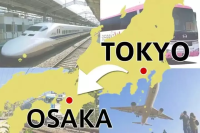





































![[2026] Top 5 Strawberry Picking Spots in Tokushima, Naruto| Farms and Access Guide for January to May](https://resources.matcha-jp.com/resize/720x2000/2025/03/06-227165.webp)
![[Yamanashi/ Hokuto City] 4 Hot New Spots Opening in 2026](https://resources.matcha-jp.com/resize/720x2000/2025/12/12-252747.webp)


